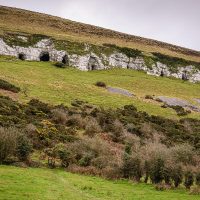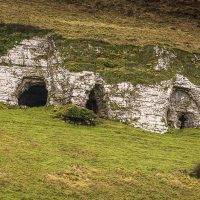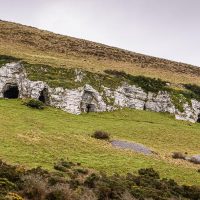The Kesh Caves (or Keash Caves, the caves at Kesh, Keshcorran caves) are a number of caves situated side by side on the western side of Keshcorran hill, 16 chambers in all. Looking at them for the first time is a little bewildering. There are 16 in all almost in a straight horizontal line which at once weave a sense of mystical magic creating a magnetic draw on the imagination. They call out to be investigated physically, historically and through mythology.
A Brief History of Kesh Caves
The story of Kesh Caves is split into many chapters:
Chapter 1. During the last ice age Ireland was “pushed down” by the sheer weight of ice above it. The ice melted from the south so by the time it reached Sligo, the country below it was relatively ice free and ready for re-growth. When the climate pushed it back further to what is now Bricklieve mountain it revealed the mysterious Kesh Caves.
Archaeologists tell us there were residents remains found in the caves, including Artic Lemmings. That suggests that during the time it took to fully expose all the caves some of them became home for the Lemmings. Many other creatures like Brown bear, of the Polar bear family, Elk, Wolf and Hare were also found and carbon dated to 10,000 B.C. The ice started receding about 12,000 years ago.
Chapter 2: Hunter Gatherers came to Ireland about 10,000. As their name suggests they lived by hunting, fishing and eating berries and as they were nomadic people, did not settle in one area and had knew nothing of the benefits of a settled community or farming. If they had came across the Kesh Caves they may have used them periodically ( A metacorpus of a reindeer was found near a charcoaled burnt area, telling us there animals lived in Ireland when the hunters were there and one of them liked roast reindeer) but not lived in for long periods. but could have left some animal bones behind them from time to time. That would co- inside with that time frame.
What is more likely is that the Carnivores of the period used them as their dining halls.
Chapter 3: Above the caves, at the summit on the hill, is a Cairn call Keshcarron and at 360m high is the highest cairn in Sligo which suggests the person or people buried there must have been held in very high regard by those remaining. It sitting proudly overlooking a panoramic view to die for. Being part of the Carrowkeel-Keshcorran complex it likely dates back to the Neolithic/Bronze age. It has not been excavated, as Carrowkeel has, and been radiocarbon dated to 3,500 to 2,5oo years old, so it’s a fare bet Keshcarron cairn is of a similar age.
What is perplexing is the importance that must have been attached to the summit’s cairn and immediate surrounds as, beside it are two parallel ditches in, what looks to have been, an arena for large gatherings. The immediate suggestion is that it was made for commemorations for those buried in the cairn. Could it, however, have been used in conjunction with the rest of the country for rituals and celebrations for Errach, Lughnasa and Samhain.
Kesh Caves provides another conundrum. Why, during this time was there still no sign of human habitation at Kesh caves, can it be that being on the same mountain as the cairn they were considered sacred, not for habitation?.
Chapter 4: At last interest was shown in the real estate as five human teeth were found in various caves, along with man made objects synonymous with 10 A.D. like bone needles, an iron saw, bronze pins, and an adze stone axe. More indications of regular settlement were the shells of mussels and oysters were discovered.
For more information on the Carrowkeel-Keshcorran complex visit: The Carrowkeel Megalithic Complex website.
Your Visit to Kesh Caves
The best place to start a Kesh Caves adventure is probably from the visitor center at The Fox’s pub in Keash village. From here, park the car and walk to the starting point above on the hill.
At first glance up a person could be forgiven for thinking they had strayed into The Shire and expecting Bilbo Baggins at any moment to appear or conversely into the barnyard at Hogwarts from where the appearance of Hagrid would not surprise.
It is, after all, where an Irish High King Cormac Mac Art was born and brought up by wolves, where a Roscommon woman was dragged underground from Oweynagcat, Roscommon (the entrance to the Otherworld) to the Kesh Caves by a crazed cow and where Fionn Mac Cumhaill so nearly met his demise by the skullduggery of the Cailleach.
This area is laden with mythological and folklore stories for those interested but they are not part of this scenario, all are easily found on Google.
Before starting, make sure to wear suitable footwear and clothing for soggy, boggy terrain particularly when reaching the brow of the hill. A walking stick will be very useful. Another “must” to bring is a camera as the photos taken from inside the caves, downhill to the plains, will make you understandably proud. On then to the Cairn which, when seen first hand ( as described above), make the day’s trip worth it alone, especially by letting the imagination run free. The 360 degree panorama view is glorious.
An easier Climb to the top is from the north east of the hill from Cairnaweeleen which has not been excavated either.




